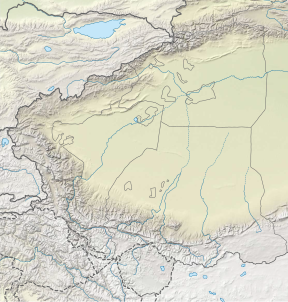Gasherbrum I (Balti: རྒ་ཥཱ་བྲུམ་། - ༡, romanized: rgasha brum - 1, lit. 'Beautiful Mountain - 1'; Urdu: گاشر برم - ۱; simplified Chinese: 加舒尔布鲁木I峰; traditional Chinese: 加舒爾布魯木I峰; pinyin: Jiāshūěrbùlǔmù I Fēng), surveyed as K5 and also known as Hidden Peak, is the 11th highest mountain in the world at 8,080 metres (26,510 ft) above sea level. It is located between Shigar District in the Gilgit–Baltistan region of Pakistan and Tashkurgan in the Xinjiang of China. Gasherbrum I is part of the Gasherbrum Massif, located in the Karakoram region of the Himalaya. Gasherbrum is often claimed to mean "Shining Wall", presumably a reference to the highly visible face of the neighboring peak Gasherbrum IV; but in fact, it comes from "rgasha" (beautiful) + "brum" (mountain) in Balti, hence it actually means "beautiful mountain."
Gasherbrum I was designated K5 (meaning the 5th peak of the Karakoram) by T.G. Montgomerie in 1856 when he first spotted the peaks of the Karakoram from more than 200 km away during the Great Trigonometric Survey of India. In 1892, William Martin Conway provided the alternate name, Hidden Peak, in reference to its extreme remoteness.
Gasherbrum I was first climbed on July 5, 1958, by Pete Schoening and Andy Kauffman of an eight-man American expedition led by Nicholas B. Clinch, Richard K. Irvin, Tom Nevison, Tom McCormack, Bob Swift and Gil Roberts were also members of the team.[5]: 210–212
- ^ a b Cite error: The named reference
peakbaggerwas invoked but never defined (see the help page). - ^ Cite error: The named reference
cknpwas invoked but never defined (see the help page). - ^ Hajzer, Artur (2012). "Gasherbrum I (8,086m), First Winter Ascent". American Alpine Journal. #54 (86). ISBN 978-1933056753. ISSN 0065-6925. Retrieved 25 May 2024.
- ^ Bielecka, Agnieszka; Hajzer, Artur (2013). "The Polish Gasherbrum I Winter Expedition" (PDF). Alpine Journal. #117 (361): 15–20. ISSN 0065-6569. Retrieved 25 May 2024.
- ^ Clinch, Nicholas (1982). A Walk in the Sky: Climbing Hidden Peak. New York, Vancouver: The Mountaineers. ISBN 0898860423.




